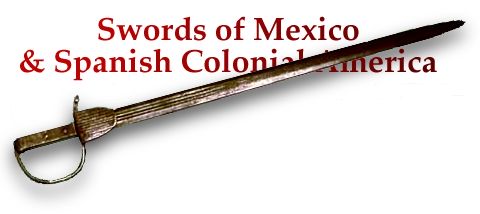| The tang was as wide as the grip and formed a core to which
the swordsmith attached horn or wood on both sides in an intermediate position.
He placed these under two metallic plates that when seen in cross-section,
formed the sides of what aproximated a square grip.
The blades of earlier espada anchas tended to be double-edged and with
a flattened hexagonal cross section.
The blade in example 1
is typical of the usual patterns that possess two to four narrow, shallow
fullers on each face of the blade. These are limited to the one-third to
half of the blade nearest the hilt. A very short ricasso is also typical.
Many divergent styles of blades were used. Espada anchas, as shown in
example
2, have a single fuller blade. In the detail, shown at the left
you can see that it is etched with sun, moon and stars figures on each
side. Another common motif was the "arm with sword".
Such blades were found in diverse settings throughout the world in the
17th through 19th centuries. Generic blades, usually of European manufacture,
were locally mounted.
Saharan
Tuareg takoubas have been documented with similar European blades,
such as the three-fullered variant as well as those engraved with astrological
devices.
Similarly, examples of a short sword blade with similar etched decoration
to that in the second example have been seen mounted in an English basket
hilt that is characteristic of early 17th Century swords.
Engraved mottoes: No me saques sin razon (Do not draw me without
reason) and No me embaines sin honor (Do not sheath me without honor)
are commonly found on espada ancha blades.
Beginning late in the 18th Century single edged variants of the espada
ancha begin to appear and later to predominate. This trend increased
until the early 19th Century.
example 3
The early double-edged espada anchas tended to be lightweight
when compared with the slightly curved to straight single-edged variety.
These possessed a broader, thicker blade similar to the all-purpose guard-less
campesino's
(peasant) machete. 4
While the earlier form had a well-made blade from a specialized workshop,
these later forms often have fairly crude blades, most likely of local
manufacture.
In the 19th Century, cut-down, reused military saber blades were also
seen in espada ancha mounts. Similarly, military style multi-branched guards
become more common in the mid-19th Century mounted on typical broad, slightly
curved single-edged blades.
With continued evolution, the laminated, riveted hilt was supplanted
by forms with narrower tangs entirely encircled by wood or horn. example
4
While the former double-edged sword was foremost a weapon and hunting
accessory, the later single-edged form is clearly an all purpose tool equally
useful as a weapon or for clearing brush and chopping wood.
Thus, by the close of the 19th Century, the espada ancha has
become essentially a machete with a guard. This along with handmade guardless
machetes
was supplanted by the commercially made machetes still in use in Mexican
agriculture at the end of the 20th Century. |

